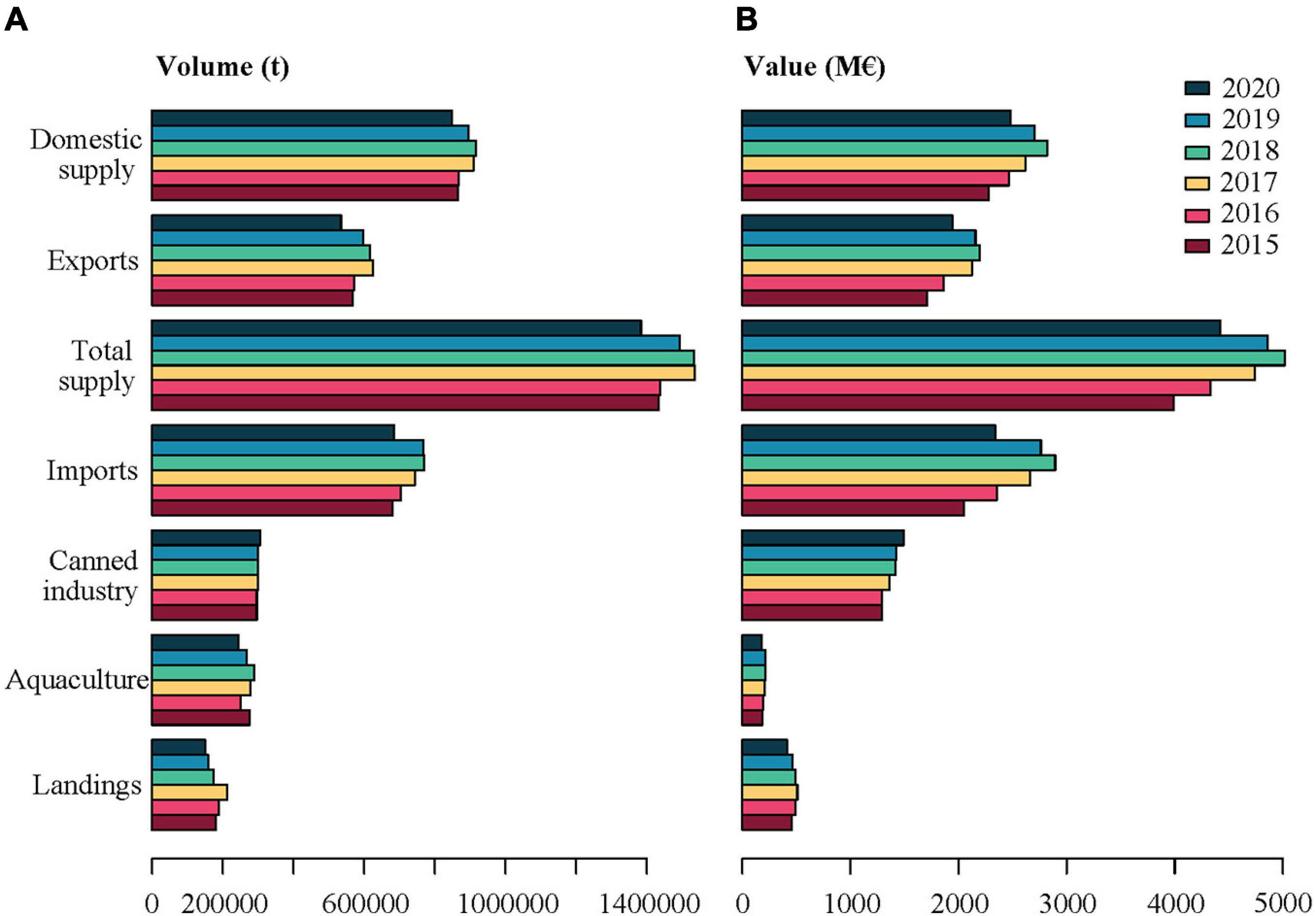Rapid Assessment of the COVID-19 Impacts on the Galician (NW Spain) Seafood Sector
- 1Faculty of Business Administration and Management, University of Santiago de Compostela, Santiago de Compostela, Spain
- 2Cross-Research in Environmental Technologies (CRETUS), Department of Applied Economics, University of Santiago de Compostela, Santiago de Compostela, Spain
- 3Faculty of Economics and Business Administration, University of Santiago de Compostela, Santiago de Compostela, Spain
- 4ECOBAS and FCETOU, University of Vigo, Vigo, Spain
This paper aims to develop a rapid assessment of the COVID-19 impact on the Galician (NW Spain) seafood sector, one of the most important maritime regions in the world. Here, we focus not only on the immediate COVID-19 impacts on the extractive fisheries sector, but also on the capacity of the aquaculture and the canned industries to supply seafood markets before and during the pandemic. We synthesize multiple data sources from across the seafood supply chain to show the relative initial responses and variables of recovery during a pre-COVID-19 period (2015–2019) and during the pandemic (2020). Our study shows that seafood sectors and trade were disrupted by abrupt shifts in demand, supply and limitations on the movement of people and goods, with a wide range of impacts and consequences for the seafood sectors. We find that domestic landings, Galician aquaculture production and imports and exports of seafood products (fresh, live and frozen) in 2020 showed an important decrease. In contrast, the canned production and the imports and exports of prepared and preserved seafood products followed an increasing trend during the COVID-19 pandemic. We record a change in the consumption behavior of the Galician population, which significantly increased expenditure in fresh and canned seafood products during the first confinement. Overall, the Galician seafood sectors were able to ensure the supply of seafood products to the population during the period of confinement decreed as a result of the COVID-19 crisis. Proximity to markets, investment in domestic or nearby supply chains and the development of new technological innovations helped to avoid food shortages and loss of livelihoods in Galicia. Fishers and fishing enterprises have also acted collectively to reassert their rights to provide essential and high quality seafood products to the Galician population, their livelihoods and safe working conditions, and have leveraged relationships and collaborations with their government counterparts to continue fishing.
Introduction
The COVID-19 pandemic and resulting economic and financial crisis represent a global-scale disturbance that has impacted all economic sectors (Food and Agriculture Organization of the United Nations [FAO], 2020). Economic impacts may also differ across countries and industries due to previous capacities in terms of efficiency and resilience (Bennett et al., 2020; Love et al., 2021; White et al., 2021). Particularly, in the seafood industry, key activities such as the extractive fisheries, aquaculture and canned sectors have been disrupted or stopped by COVID-19 impacts. Seafood is among the most traded food commodities in the world (Food and Agriculture Organization of the United Nations [FAO], 2020), and the growth of seafood trade has resulted in a wide range of socioeconomic benefits, including employment opportunities and food security for coastal communities (Stoll et al., 2020). However, this growth also makes the seafood system highly vulnerable to social-ecological shocks that disrupt the flow of products and the livelihoods that depend on it (Cottrell et al., 2019; Stoll et al., 2020). Seafood trade has also been affected by the COVID-19 pandemic due to impacts on the supply or demand side, depending on the capacity of a territory to satisfy the domestic seafood consumption and, alternatively, to provide seafood products to foreign countries (Scientific, Technical and Economic Committee for Fisheries [STECF], 2020, 2021).
Recent studies dealing with the impacts of COVID-19 on fisheries have focused on several areas, including: the immediate effects on the fisheries and aquaculture sectors (Food and Agriculture Organization of the United Nations [FAO], 2021); effects on coastal communities (Bennett et al., 2020) and across tropical small-scale fishing (SSF) communities in Indonesia (Campbell et al., 2021); vulnerability of SSF markets (Knight et al., 2020); impacts on the US seafood sector (White et al., 2021); responses and lessons for building resilience in the seafood system (Love et al., 2021); impacts on commercial fisheries workers (Sorensen et al., 2020); the adaptive capacity of commercial fishers in the Northeast of the US (Smith et al., 2020) and the adaptation of Newfoundland and Labrador fisheries in Canada (Asante et al., 2021); the impacts on small-scale fishers in Bangladesh (Sunny et al., 2021); and the physical distance and risks of small-scale fishers in Ghana (Okyere et al., 2020). In the European Union (EU), research efforts have focused on marine fisheries in the Mediterranean Sea (Coll et al., 2021); UK fisheries (Kemp et al., 2020); and the economic effects on the fisheries (Scientific, Technical and Economic Committee for Fisheries [STECF], 2020) and aquaculture sectors (Scientific, Technical and Economic Committee for Fisheries [STECF], 2021).
Although these studies are necessary and important, none have focused entirely on the impacts of COVID-19 on the seafood supplier sectors. Therefore, this paper aims to develop a rapid assessment of the COVID-19 impact -namely on volume and value production, prices and seafood trade-, on the Galician seafood sector, one of the most important maritime regions in the world (including small-scale and industrial marine fisheries, shellfisheries, the aquaculture industry and the canned seafood industry). Here, we focus not only on the immediate impacts of COVID-19 on the extractive fisheries sector but also on the capacity of the aquaculture and canned industries to supply Galician and global seafood markets before and during the pandemic.
Study Area
The Galician coast (NW Spain) extends for approximately 1,295 km and has a highly varied morphology, with rías and inlets, cliff areas with beaches or marshes, and areas (Penas, 1986). From a biological point of view, the Galician rías are ecosystems with high primary production. The richness of Galician rías, which consist of old tectonic valleys occupied by the sea as a result of the high sea level during the last glaciations, is due to upwelling phenomena (Fraga and Margalef, 1979).
Galicia is such an important area for fishing because, for example, primary production can reach 250 g C/m2/year in the Ría de Arousa, the most extensive estuary of the Rías Baixas (Varela et al., 1984), which is far higher than the average primary production observed in the Atlantic Ocean (100 g C/m2/year) and is close to the estimated average for land ecosystems (Fraga and Margalef, 1979). The fisheries sector is a major contributor to the regional gross domestic product (GDP) (Galician Institute of Statistics [IGE], 2020; Pascual-Fernández et al., 2020). Galicia is also the main fishing region in Spain (Freire and García-Allut, 2000), and one of the most fishing dependent areas in the EU (Villasante et al., 2016). Galicia accounts for around 40% of Spain’s fleet, approximately 60% of total Spanish employment in fishery-related sectors and 50% of catches reported by Spanish fishing vessels in EU waters (Scientific, Technical and Economic Committee for Fisheries [STECF], 2020; Xunta de Galicia, 2021).
Materials and Methods
Media Reporting on COVID-19 and Galician Seafood
The impacts of COVID-19 on the Galician fisheries sector were studied by analyzing the frequency of the use of words in press articles about this topic. Thereby, the texts of all articles that included the keywords “covid,” “fishing,” “shellfishing,” and “Galicia,” from March 2020 to February 2021, were collected by using the open search engine Google News. Additionally, the same search was carried out without the keyword “covid” in order to compare the results. The text of the articles was pooled in a single file and the relative frequency of the words used in the articles was obtained by using the termdocumentmatrix tool included in the tm package (Feinerer and Hornik, 2014) of the R statistical software version 4.0.4 (R Development Core Team, 2020).
The frequencies of the most recurrent words (frequencies > 0.09% of the total) were plotted, after translation into English, using the wordcloud tool of the wordcloud package (Fellows, 2013) of the R statistical software R. Common stop words were before removed using the stopwords and removeWords tools of the tm package. While this information is not intended to represent a complete accounting of all press coverage in Galicia on the impacts of COVID-19 on the fisheries sector, it does represent a sample of the early impacts on the supply chain of fishery products (wild catch and aquaculture) from small-scale fisheries and industrial production.
Official Seafood Production Statistics
In Galicia, the only official statistical data regarding fishery product landings in all fish markets are available at the Fishing Technological Platform PescadeGalicia,1 which is developed by the Galician Regional Government. PescadeGalicia collects daily information about transactions for 294 commercial species traded in the 64 fish markets governed by the Galician Administration. This information is extracted from sales receipts issued by species and auction markets that are provided to the Platform by the owners of fresh fish and shellfish-selling markets. For each 6-year period available, landing data can be retrieved based on fish markets or traded species for the desired periodicity (weekly, monthly, or even daily).
Galician fish markets receive landings from both local fishing areas and those far away from the local coast. Although the Galician Autonomous Government has invested significant effort to improve the reliability of its fishery statistics in the last decade, the database does not provide complete information about the origin of landings (Rocha et al., 2004; Otero et al., 2005; Villasante et al., 2015) therefore we do not include this data in our analysis. Furthermore, data on discards and Illegal, Unreported and Unregulated (IUU) data are unavailable and not included.
For the canned industry, Anfaco-Cecopesca2 provided data for Galician production by type of seafood products (fish and bivalves), while the Galician Regulatory Mussel Council3 provided information on mussel production. In every case, we used data for all commercial landings from the previous 5-year period (2015–2019) to the year when COVID-19 restrictions began in Spain (2020).
Official Seafood Trade
Seafood products (fresh and frozen landings, canned and aquaculture species) constitute an important market product in Galicia, where they are considered a top seafood attraction in first-class restaurants. To analyze the seafood supply, we used the Galician monthly seafood trade data (in volume and value) which come from the DataComex Database.4 The dataset includes information about imports and exports (in volume and value) of fresh, frozen and canned fish, crustaceans and mollusk products by origin and destination (e.g., countries) from the previous 5-year period (2015–2019) to the year when COVID-19 restrictions began in Spain (2020).
Household Expenditure on Seafood
We study seafood demand by analyzing official household food consumption data downloaded from the Spanish Ministry of Agriculture, Food and Environment’s Food Consumption Panel5 for the period 2015–2020. This panel provides data about household demand on food (including seafood) from the Spanish population. Monthly expenditure (in euros per inhabitant) on fresh, frozen and canned products (fish, mollusks and crustaceans) in Galicia was collected from this panel. Logarithmic transformation was performed to evaluate the monthly evolution and trend of expenditure (€ per capita) and price (€/kg) on fresh, canned and frozen products (including fish, mollusks and crustaceans).
Results
Media Reporting on COVID-19 and Galician Seafood
In total, 214 press articles (109 with the keyword “covid” and 105 without) in 36 different media (print and digital newspapers) were collected from March 1, 2020 to February 15, 2021 (Figure 1). During the first 2 months (March to April 2020) 88.1 ± 8.81% of the press articles published on the Galician fishing sector were related to COVID-19. During the following 4 months (May to September 2020) this percentage decreased to an average of 55.6 ± 10.8%, and by October 2020 to February 2021, these press articles represented only 16.8 ± 9.8%. The number of covid-related press articles decreased progressively from March 2020 to February 2021, unrelated to the COVID-19 waves.
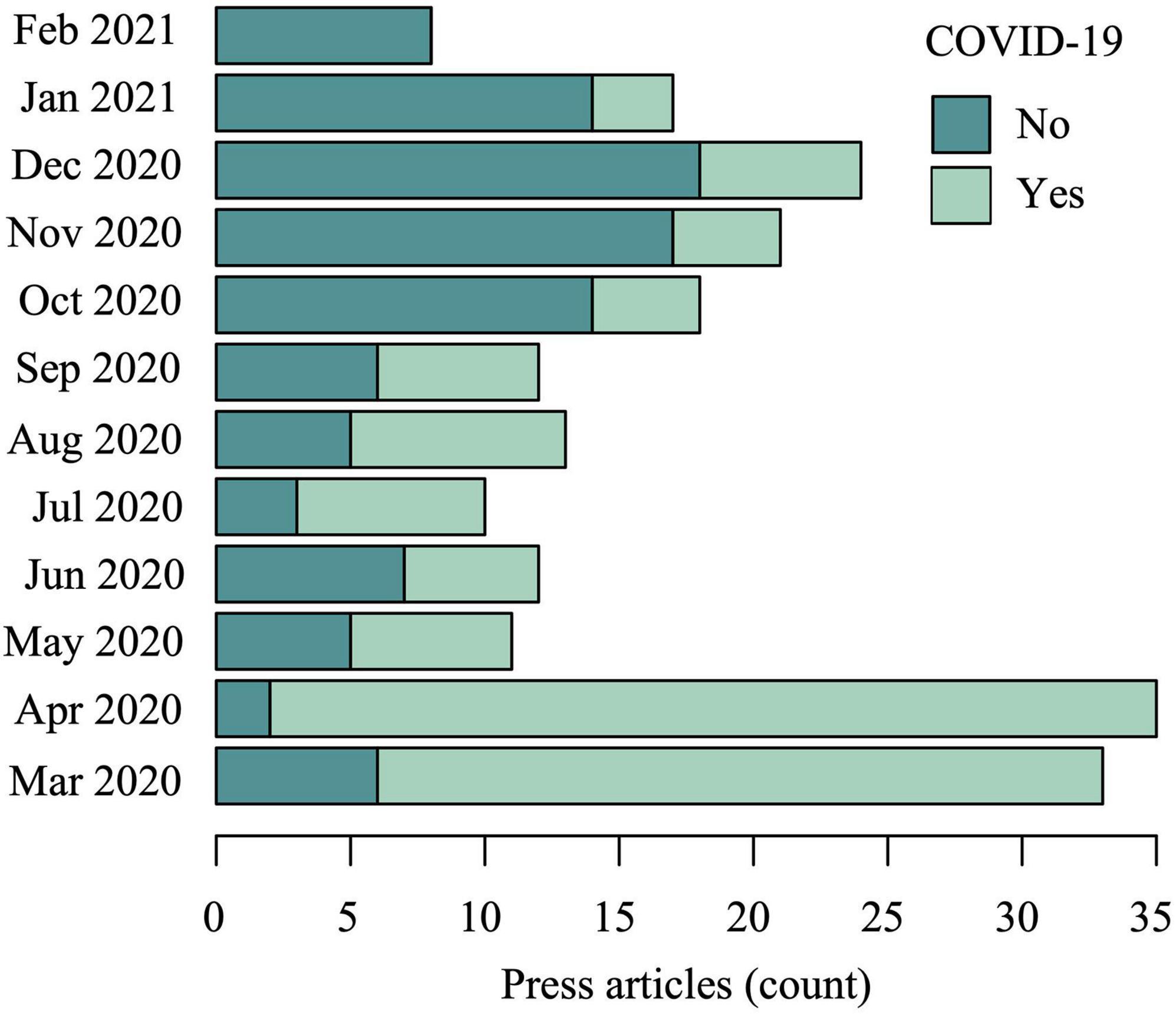
Figure 1. Press news (count) about the Galician fisheries sector published with the keyword covid (light green) and without it (dark green) from March 1, 2020 to February 15, 2021.
A notable proportion (2.8%) of the words used in Galician press articles about the fisheries sector and COVID-19 pandemic (109 articles) related to the impact of the pandemic on the markets and to economic grants for the sector (Figure 2A). Words in press articles, like “products,” “euros,” “prices,” “grants” or “fish markets” (frequency > 0.5%), were all related to this. In contrast, articles (105) that did not mention COVID-19 mostly related to the dredging of shellfish beds, shellfishing management and European fisheries funds (Figure 2B). Words like “cofradías,” “activity,” “xunta,” “euros,” “zones,” “million,” “Europe,” “government,” “A Coruña,” “plan,” “dredging” or “consellería” (frequency > 0.2%), were all related to these topics.
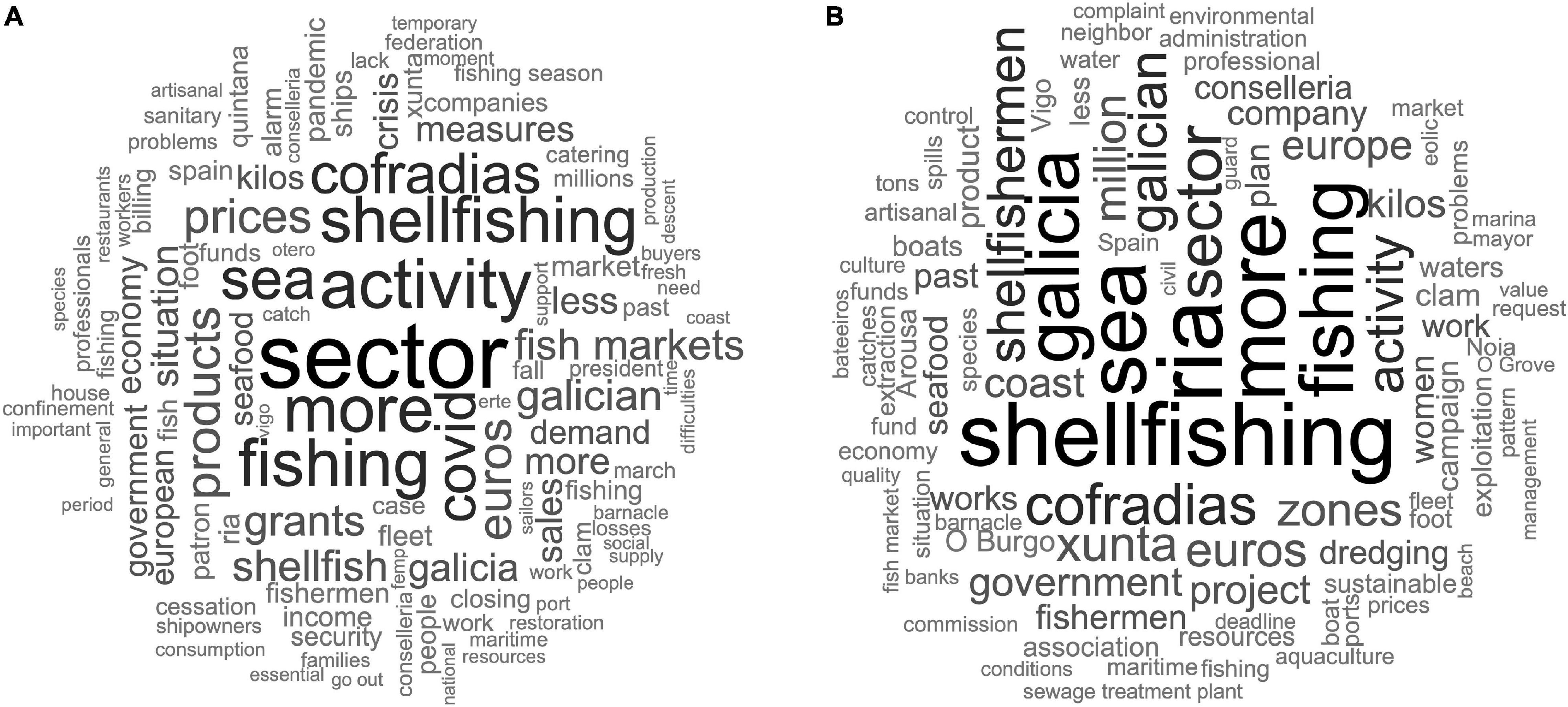
Figure 2. Relative frequency of use of the words included in Galician press news about the fisheries sector, with the keyword covid (A) and without it (B). Letter size refers to frequency; only the most frequent words (>0.09% of the total) were plotted.
Domestic Landings
In 2020 more than 150,000 tons of seafood were sold in the Galician first sale markets, with an overall value of € 413 million (Table 1). Finfish were the group of species that in 2020 showed higher landings (138,006 t) and economic value (€ 303 M), followed by bivalves (6,481 t, € 67 M), cephalopods (3,185 t, € 18 M), crustaceans (1,210 t, € 19 M), echinoderms (723 t, € 6 M), seaweeds (432 t, € 0.3 M), and miscellanea (213 t, € 0.7 M), while sea worms sold as angling bait (4 t, € 0.2 M), and gastropods (2 t, € 0.02 M) were less important for the fisheries sector (Table 1).
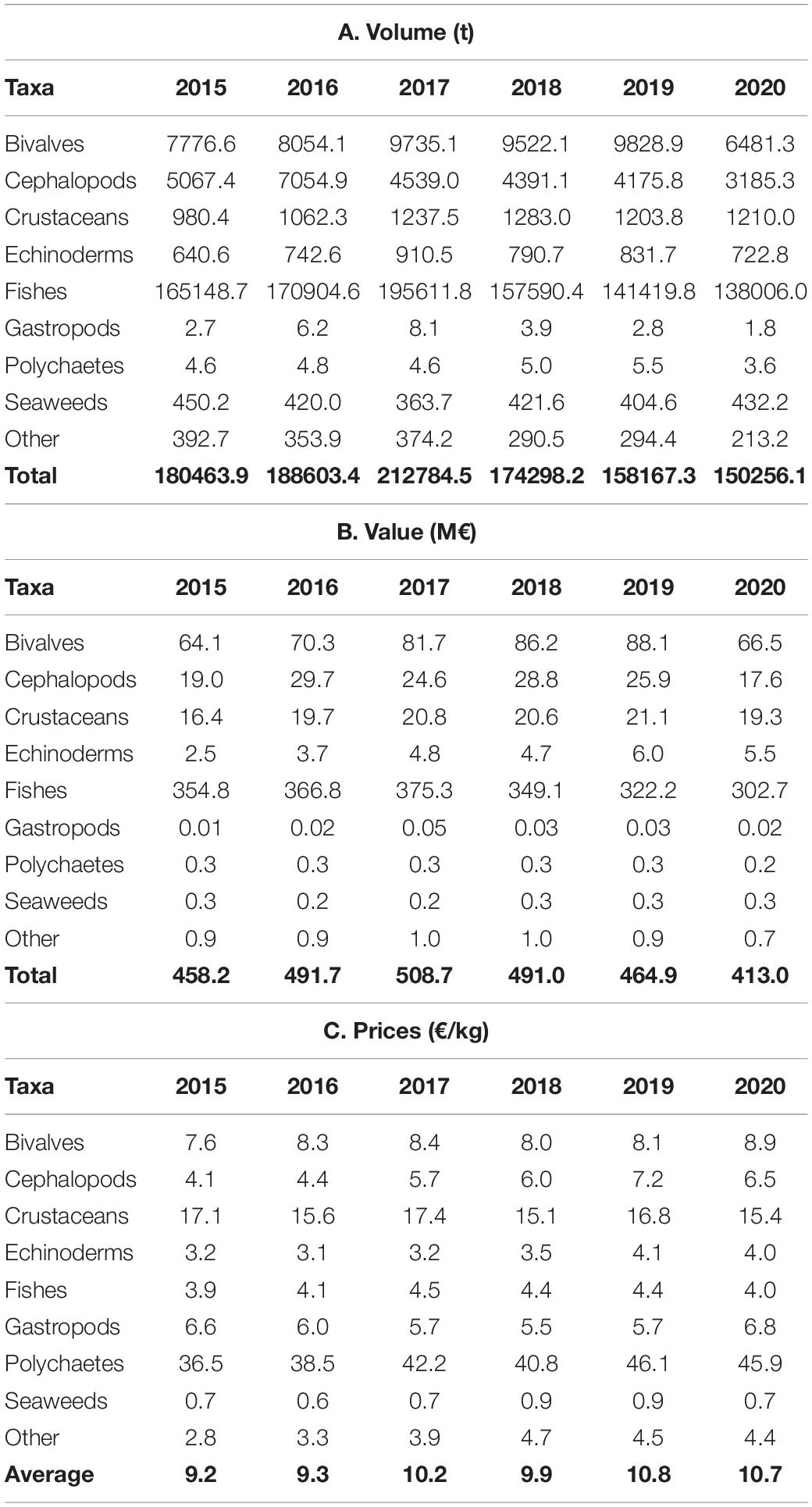
Table 1. Annual landings in (A) volume (t), (B) sale value (M€), and (C) prices (€/kg) by main biological groups between 2015 and 2020 in Galicia.
Compared with the average of the previous 5 years (2015–2019), total landings in 2020 showed a relevant reduction, both in terms of volume (18%; Figure 3A), and economic value (14%; Figure 3B). Although gastropods showed the sharpest reduction in landings (62%) and commercial value (31%) their relatively low importance with respect to the total species traded in Galician first sale markets only implied a minor economic impact for the sector, of about € 8,000. On the contrary, despite the reduction in finfish sales being moderate (17 and 14% in volume and value, respectively), the economic impact exceeded € 50 million. The strong reductions in the sales of bivalves and cephalopods also caused important economic impacts, representing losses of € 12 million, and € 8 million, respectively.
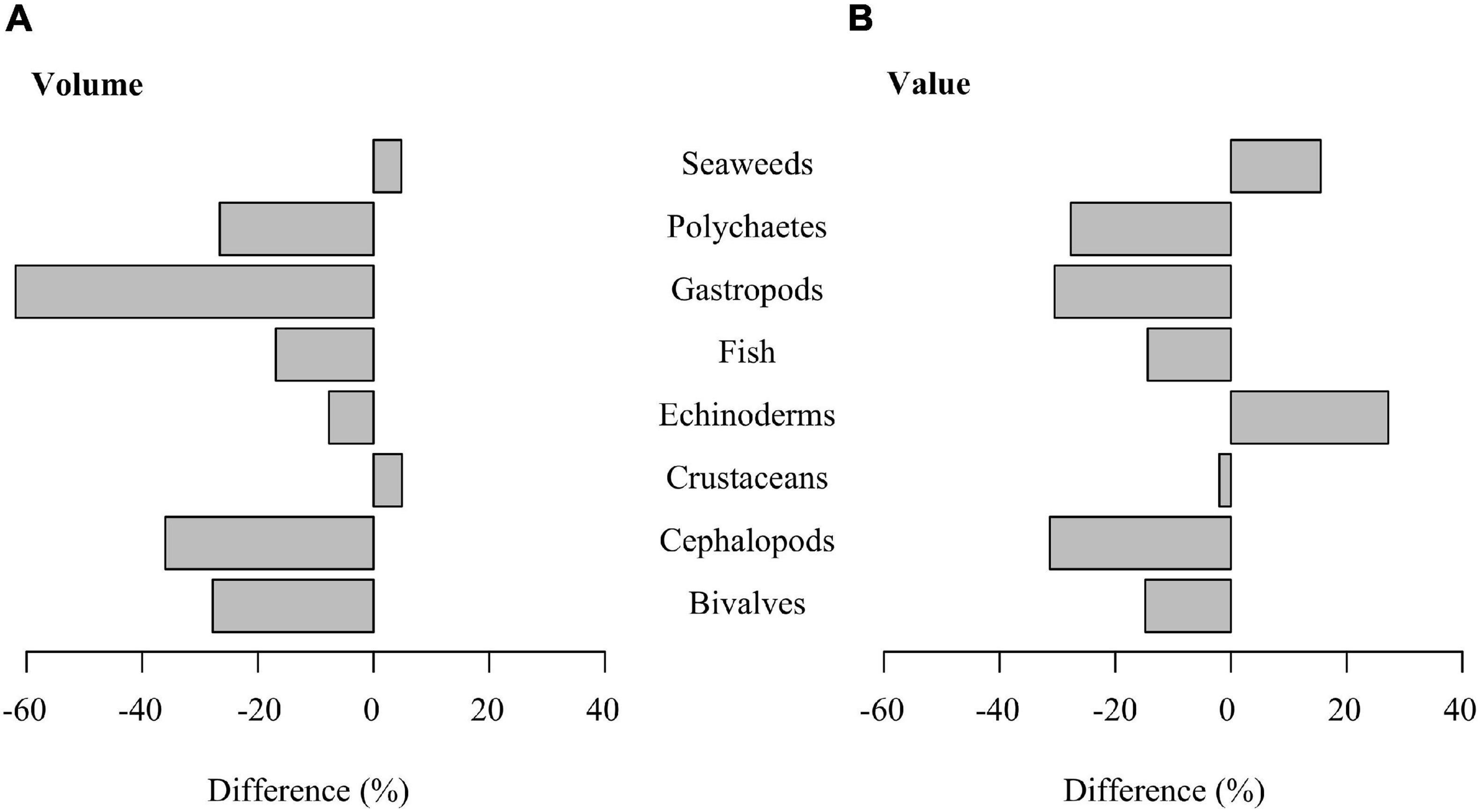
Figure 3. Difference (%) in annual landings in (A) volume and (B) sales value by main biological groups between 2015 and 2019 vs. 2020 in Galicia.
The landings of seaweeds did not contract in 2020, and even experienced a moderate increase in economic value (15%). Notably, echinoderms also showed a steep increase in the value obtained from sales (27%), despite a reduction in their landings (8%). These increases in value contrasted sharply with landings of crustaceans where, despite a slight increase in landings (5%), fishers obtained lower economic benefits than in previous years (2%). The strong reduction in sales of sea worms is notable insofar as it reflects the significant reduction seen in the demand for fishing goods for recreational activities.
Domestic Supply and Seafood Trade
Most of the research studies about COVID-19 impacts on fisheries mainly focused on specific variables such as catches, landings or revenues (Scientific, Technical and Economic Committee for Fisheries [STECF], 2020; Asante et al., 2021; Campbell et al., 2021; Coll et al., 2021). While these studies are important, it is also critical to consider early impacts and responses on the fisheries sector by analyzing the landings trends which are part of the local production. This is because a social-ecological crisis could also affect the capacity of the seafood sectors (fisheries, aquaculture and the canning industry) to cover seafood demand by imports and/or exports (White et al., 2021).
Regarding local production, our results show that Galician landings suffered a 17 and 14% reduction in volume and value, respectively. Overall, the impact of COVID-19 on shellfishers on foot caused low economic loss. This is because in general the regional government financially compensated this sector with public aid, which helped to maintain a similar level of income according to previous years. However, the shellfishers on boat suffered a complete economic loss in the following months after the first confinement. In some Galician rías, with the restart of the activity in May and June in 2020 the losses cannot be calibrated by the presence of toxin, which prevented shellfishing for many days. The SSF sector (namely harvesting hake, horse mackerel, octopus, sardine) also suffered a reduction in landings due to a drop in prices, being unable to sell their products at auction markets, loss of traditional clients (schools, hospitals, HORECA), and a lack of demand from tourists and international clients.
The health of fishers was also affected after the first lockdown (March 2020) because they were scared about the virus, not only due to the lack of space on board to respect social distancing between crew members and the scarcity of sanitary material for fishers, but also because of the need to protect family members. This ultimately made it difficult to find crew for fishing vessels. One of the most important and valuable SSF in the EU, the Galician common octopus fishery, was synergistically affected by changing environmental conditions, overfishing and the COVID-19 pandemic. This combination of perturbations led to a reduction of 52% in landings (from 2,100 t in 2019 to 1,000 t in 2020) and 51% in value (from 16.1 million euros to 7.8 million euros in the same period) (Xunta de Galicia, 2021). Such drastic changes in landings can lead to disruptions of local and international seafood dynamics and coastal communities that, combined with abrupt shocks such as from COVID-19, can seriously impact SSF viability because of the effects of a decrease in productivity on enterprises’ revenues and the rapid growth in uncertainty.
Our results also indicate that other seafood sectors apart from fisheries (e.g., the aquaculture and canning industries) have also been affected by COVID-19. Indeed, Galician aquaculture production decreased by 10.6 and 12.4% in volume and value, respectively, in comparison with the average production during the previous 5-year period (2015–2019) (Figure 4).
The aquaculture sector in Galicia is dominated by mussel production, which accounted for 95% of the total aquaculture in volume (255,513 t) and 53% in value (€ 111.8 million) in 2019 (Xunta de Galicia, 2021). Regarding mussel production, official data indicate a reduction of 8.9 and 9.7% in volume and value in the periods before (2015–2019) and during COVID-19 (2020) (Xunta de Galicia, 2021). The most direct effects for aquaculture companies have been the reduction in incomes due to the decrease in sales and prices, and the increase in operating costs, mainly feed. In the medium term, producers are also concerned about a potential drop in prices once the markets open and all producers market the accumulated stocks [Spanish Aquaculture Business Association [APROMAR], 2020].
Although the mussel sector made huge efforts to continue extracting mussels from rafts and developing the activity during the COVID-19 pandemic, it appears to be difficult to recover the level of production before the pandemic. Demand for fresh mussels certified by the Galician Protected Designation of Origin (PDO) has reduced due to lower demand from European markets (namely France and Italy) and the closure of traditional HORECA channels (restaurants and hotels). However, consumer demand for transformed and canned mussels continued to be stable after the first lockdown.
The COVID-19 pandemic was not the only factor which negatively affected mussel production in Galicia. The sector suffered, again, the occurrence of red tides in the Ría de Pontevedra, and partially in other rías (e.g., Ares-Betanzos, Muros-Noia), as a result of which the extraction of mussels was prohibited from April to June of 2020. The sector also suffered considerable delays in collecting sales payments, attributed to organizational difficulties that arose due to the state of alarm in the country (Galician Mussel Regulatory Council, 2021). Another factor which influenced the development of the Galician mussel market is that imports of mussels from Italy seem to have increased during the lockdown (Galician Mussel Regulatory Council, 2021).
Our results also show that the canned sector (mainly the large companies) has been able to positively adapt to the COVID-19 pandemic. Indeed, canned production increased 2.2% in volume and 9.8% in value in 2020 compared to the previous 5-year period due to the response of the Galician population to obtain a regular, safe and high quality of seafood (Figure 4). The characteristics of these products in terms of durability, ease of storage and versatility have favored their immediate collection at Galician households, which will imply a decrease in demand due to the accumulation of stocks in the near future. However, not all canned enterprises have positively adapted; small and medium enterprises suffered most, namely due to the drastic decrease of revenues because of their high exposure to HORECA channels.
Finally, imports of seafood have also decreased by 6.6% (volume) and 8.1% (value) during 2020 compared to pre-COVID-19 period, and exports suffered a 10.3% reduction (volume) and 3.4% (value), namely due to the initial shock of the lockdown in other traditional international seafood markets such as France, Italy or Portugal (Figure 5). However, these impacts have been mainly focused on fresh, live and frozen seafood trade flows, which show a reduction of imports (10% in volume and 11% in value) and exports (19% in volume and 16% in value). On the contrary, both prepared and preserved seafood follow a growing trend during the COVID-19 period, imports (9.7 and 6%) and exports (17 and 25.7%) have been significantly increased.
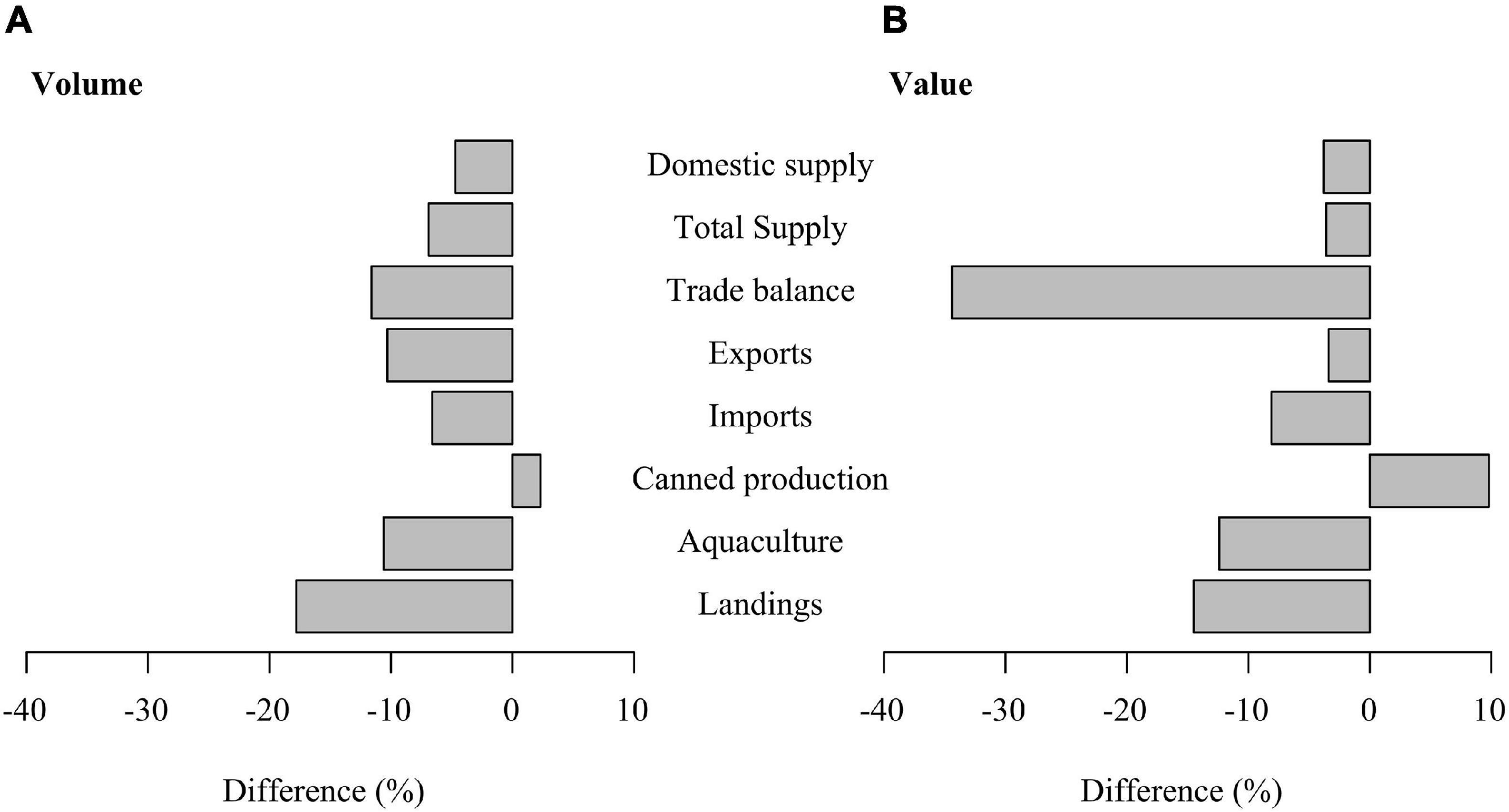
Figure 5. Impact of COVID-19 on the Galician seafood sector in (A) volume and (B) value, the difference (in %) between 2015 and 2019 vs. 2020 is shown.
The evolution of the seafood trade flows before and during the COVID-19 pandemic also affected the Galician trade balance. During the 2015–2019, the Galician seafood trade deficit was growing progressively until the pandemic emerged. However, the COVID-19 caused positive impacts on the trade balance by reducing the deficit by 11.6% in volume and 34.4% in value, respectively (Figure 5). As a result of the aforementioned results, the domestic supply of seafood products in Galicia was not seriously impacted by the COVID-19 pandemic: 4.7% in volume and 3.8% in value.
Households’ Expenditure on Seafood
Interannual variation rate in March 2020 over the previous March months (2015–2019) showed steep negative anomalies of up to –25% in expenditure on frozen products and –24% in fresh seafood, evidencing the early impact of confinement (starting on March 15th) on the consumption of seafood in Galician households. In fact, spending on fresh and frozen seafood in March 2020 was on average 15 and 9% lower (respectively) than during the same month of the previous 4 years. However, canned products increased up to 47% in the same period (41% on average), being clearly the preferred means of preservation of food for situations of high uncertainty for the population (Figure 6).
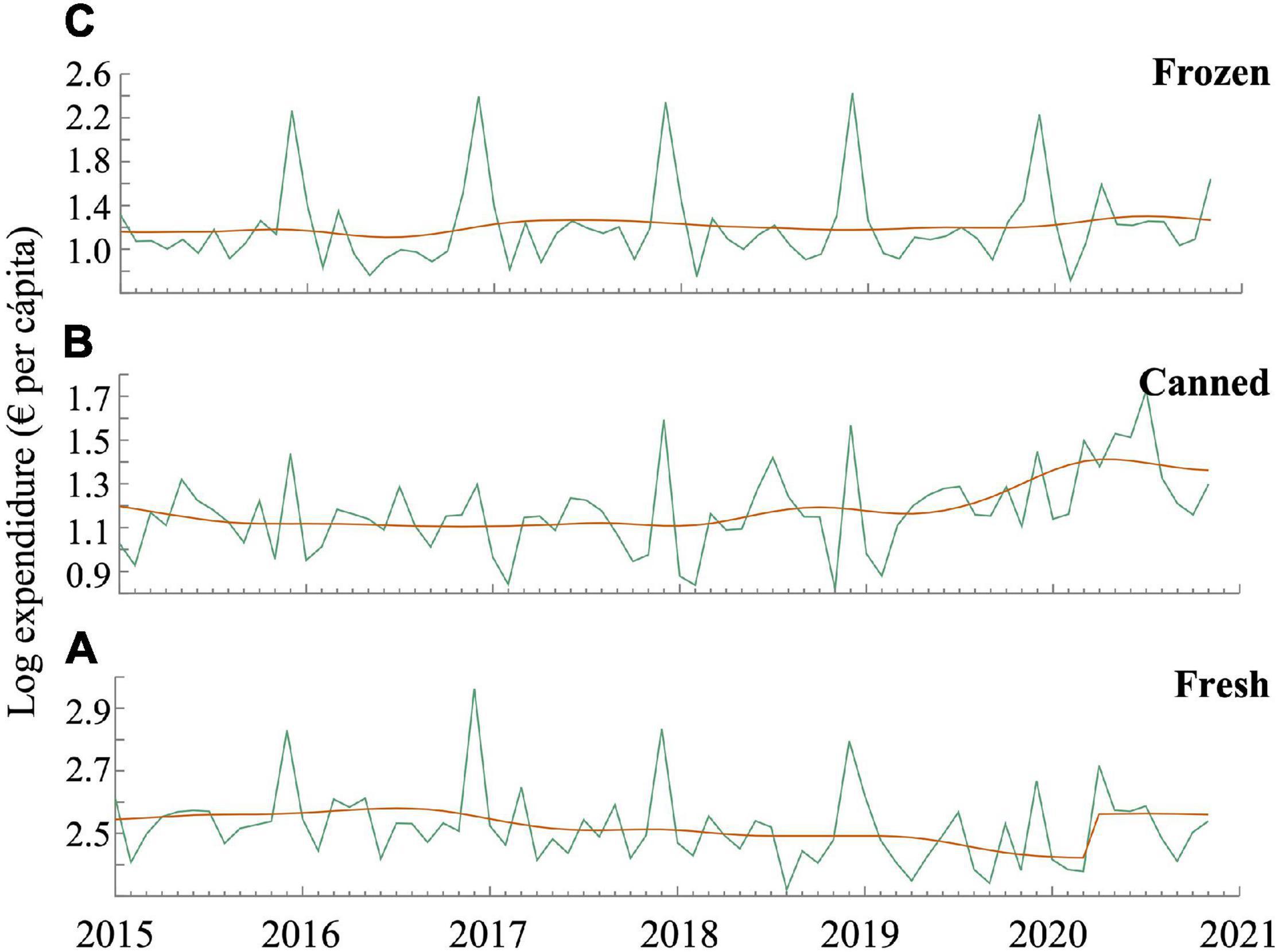
Figure 6. Expenditure (€ per capita in log) on (A) fresh, (B) canned, and (C) frozen products (includes fish, mollusks and crustaceans) in Galicia. Monthly evolution of expenditure (green) and trend (orange) were plotted.
Our results also indicate that expenditure on fresh and frozen products in Galician households experienced a notable increase immediately after the first weeks of the lockdown. Thus, in April 2020 the highest interannual increases of the analyzed period (4 years) were observed for frozen (increased by 80%) and fresh products (27%). Over the following months the expenditure of both frozen and fresh seafood tended to stabilize, and showed the traditional growth during Christmas (Figure 6).
Looking at evolution of prices (Figure 7), we found that prices of fresh seafood products suffered an anticipated reduction as it was already observed during the previous years before the COVID-19, mostly due to the closure of the HORECA channels. Prices of frozen seafood continued increasing during the whole year 2020, except in the first 2 months after the first confinement. In fact, the interannual variation rate of prices of frozen seafood in March 2020 over the previous 2 years was negative (up to –8%). Meanwhile, prices of canned seafood food did not experience significant changes over the whole of 2020 in relation to the previous years, except that prices did not grow during Christmas times as in previous years.
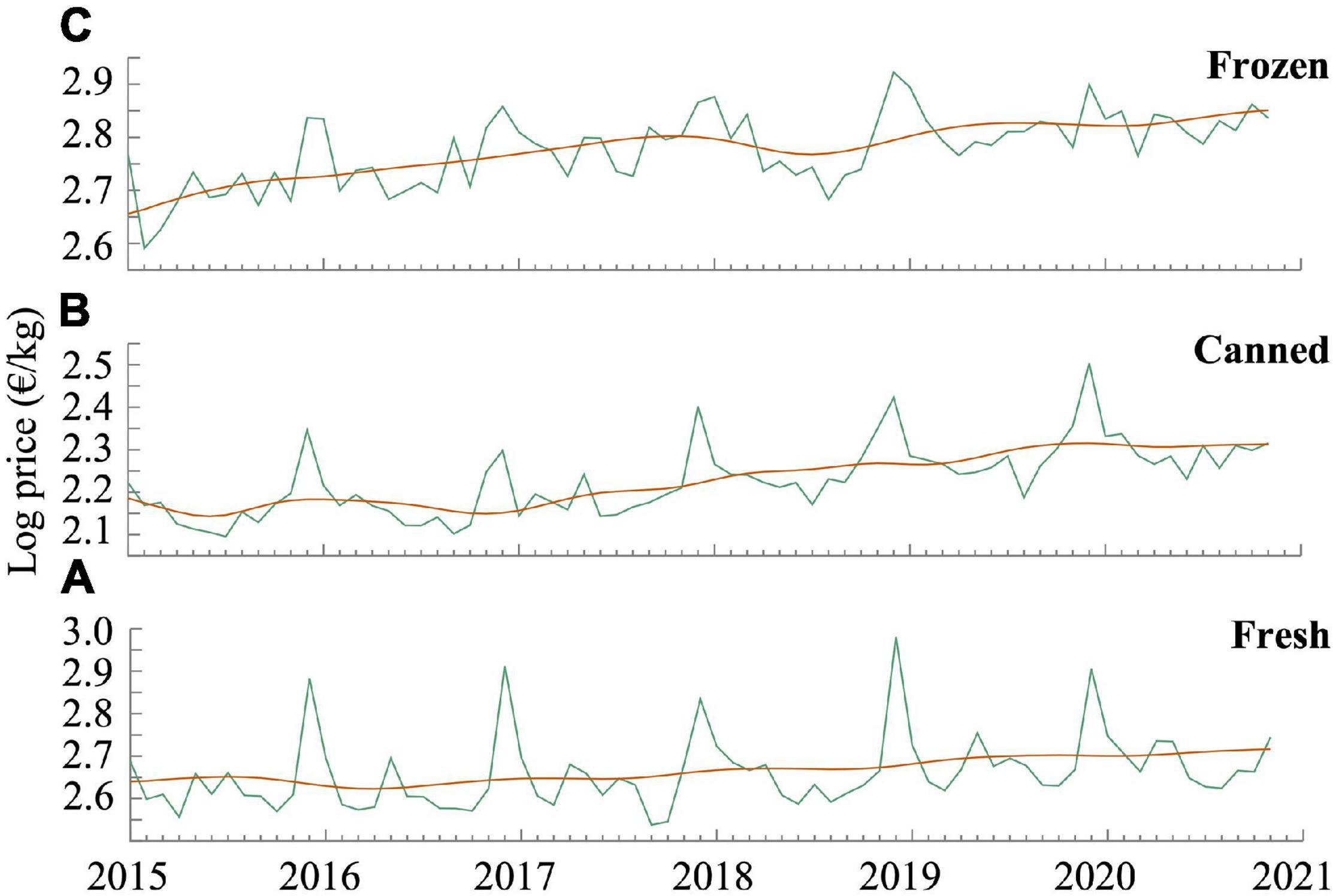
Figure 7. Price (€/kg in log) on (A) fresh, (B) canned, and (C) frozen products (includes fish, mollusks and crustaceans) in Galicia. Monthly evolution of price (green) and trend (orange) were plotted.
Discussion
The COVID-19 pandemic has highlighted the long-standing decouplings in the fisheries and seafood data availability and the need to have integrated diagnostics for rapid and effective policy (re)actions to deal with social-ecological crises (White et al., 2021). In this paper we analyzed the immediate impacts of the COVID-19 lockdown on seafood sectors in Galicia (including the fisheries, aquaculture and the canned seafood industries) with the aim of providing key insights that will be useful for policy makers when managing future social-ecological shocks or crises.
In Galicia there is a deep-rooted culture around the sea, with a profound integration of the fishing sector into Galician social norms and traditions, including the configuration of art, culture, gastronomy and language (Villasante et al., 2005). For this reason, news items about the Galician seafood sector are relatively frequent in the Galician press. The notable proportion of press releases during the beginning of the pandemic related to the impact of the pandemic on markets and economic subsidies to the sector is a reflection of the concern about the consequences of COVID-19 on the sector. Our rapid assessment based on open-access media reports and datasets shows heterogeneous impacts of COVID-19 across the seafood sectors. Regarding production, overall landings and aquaculture in 2020 showed a 14 and 12% reduction of the economic value, respectively, compared with average production in the 5-year period (2015–2019) previous to the COVID-19 restrictions due to the closure of the HORECA channels. The volume of seafood imports and exports also suffered a 6 and 10% reduction (8 and 3% reduction in value) during this period. The decrease is comparable to the global financial crisis of 2007–2008, which resulted in an estimated 7% decline in seafood exports worldwide (Food and Agriculture Organization of the United Nations [FAO], 2010). On the contrary, the canning industry production increased by 10% probably due to the response of the Galician population to obtain a regular, safe and high quality of seafood during the pandemic.
The decline of tourism in the 2020 summer season did not help recovering seafood sectors, affecting them in different ways. For example, the small-scale fisheries sector (including shellfisheries) has been seriously affected due to the closure of the traditional HORECA channels and abrupt reduction of fresh supply of these actors. These results for the fisheries sector are also consistent with the findings of the COVID-19 impacts on the EU fisheries sector (Scientific, Technical and Economic Committee for Fisheries [STECF], 2020).
The small-scale fisheries sector rapidly adapted to the abrupt shock by selling their products to other intermediaries and clients (namely the canning industry) and also by requesting financial support from the administration to support the decrease of revenues after the first lockdown. The regional administration also adopted several logistical and organizational measures to contain and mitigate the COVID-19 impacts on the fisheries sector. For example, by regulating the mandatory use of masks, use of personal protective equipment, indicate signs in the selling points of seafood products at auction markets to avoid group meetings, and avoiding sharing work equipment and physical contact between the crew with less than 1.5 m on board in vessels or in the auction markets (Xunta de Galicia, 2020a,b).
Both in the fish markets, as in the supermarkets and the fishmongers, telephone and online sales have been progressively imposed, triggering home delivery, while direct sales have also been recovering over time. The retail commerce sector has made a great effort to promote online sales and home delivery to facilitate the consumption of fresh fish products. Regarding the industrial fisheries sector which mainly operates in EU waters, around 95% of the Spanish fishing fleet (mainly based in Galician ports) continued to fish, selling their products to Spanish markets, while the majority of the freezer fleets fishing outside EU waters continued to fish too (National Federation of Provincial Associations of Fish and Frozen Products Retail Businesses [FEDEPESCA], 2020). Regarding the Galician freezing fleet, one of the key problems was the replacement of the crews due to the difficulties and restrictions of air communications, which led the shipowners to request the extension of fishing trips for a few more weeks. Another drawback was the renewal of fishing licenses due to the lack of inspectors and administrative staff in third countries as a result of the restrictions imposed on them (Spanish Fishing Confederation [CEPESCA], 2020). The high innovation of the Galician fisheries sector contributed to ensure the seafood supply during the whole course of the year, extending its adaptive capacity to commercialize seafood through new online channels, both from the auction markets to the retail distribution.
On the other hand, several mussel farms could not manage to sell all their stocks, which impacted in the form of increased operating costs. Aquaculture farms and shellfish industries selling to processors and retailers managed to maintain their levels of activity, despite the decrease in prices. The mussel aquaculture industry in Galicia suffered the initial shock due to the lockdown. However, this situation has improved after the lockdown, namely because of the high demand for mussels from the canning industry (Scientific, Technical and Economic Committee for Fisheries [STECF], 2020). In general, the operation of fishers, shellfishers, fish markets and markets, wholesalers, transporters and retailers confirmed that there were no problems in the supply of seafood. In other words, the Galician seafood sectors were able to ensure the supply of fishery products to the population during the period of confinement decreed as a result of the COVID-19 crisis.
Our results are in line with recent studies which highlight that seafood sectors and trade were disrupted by abrupt shifts in demand, supply and limitations on the movement of people and goods (Love et al., 2021). Locally caught fresh fish decreased due to the lockdown of the fleets, but household consumption of frozen and canned fish continued to remain stable or increased (Love et al., 2021). Seafood companies trading with frozen and preserved products and with consolidated trade connections with retailers are better positioned to avoid contractions in production (Love et al., 2021). However, small and medium size enterprises may have to decrease their activity due to financial risks in a scenario of increasing costs.
Financial markets have also been severely shocked as a result of the effects of the reduction in productivity on companies’ revenues and the increasing uncertainty. In a scenario of limited investments and credit (Nicola et al., 2020), solvency and liquidity appear as key factors for preventing further contractions in seafood supply causing continued losses for the companies and consumers over a more prolonged period. On March 13th, the European Commission approved the € 37 billion euro Coronavirus Response Investment Initiative (CRII) to provide small businesses and the health care sector with liquidity. On April 2nd, 2020 the European Commission launched the SURE initiative (European Commission [EC], 2020b), with a budget of €100 billion euro in the form of loans at favorable terms to support national public expenditure in developing schemes implemented for maintaining employment and workers’ incomes. In particular, the initiative supports the fisheries and aquaculture sectors to overcome the financial challenges caused by the temporary cessation of fishing activities and suspension or reduction of post-harvest production activities (European Commission [EC], 2020a; Food and Agriculture Organization of the United Nations [FAO], 2020).
Knock-on economic effects from market disruptions have mostly impacted the ability of small-scale fishers and enterprises to pursue their livelihoods through reduced demand reduction and drop in prices. As already put in place in other European countries, more or less severe lockdowns and other mobility and social distance limiting measures have been adopted in Galicia in order to prevent virus transmission and ultimately contain the growth of the death toll. Such measures have been found to be highly effective in containing the COVID-19 pandemic, but at the cost of disruption to supply chains and temporary closure of businesses and industries, with a wide range of impacts and consequences for the seafood sectors (Nicola et al., 2020; Love et al., 2021).
However, there were also positive insights that are worth highlighting to learn from the COVID-19 pandemic. Where there was a high uncertainty regarding the ability to commercialize seafood products and difficulties in logistical transportation due to the measures to contain the spread of the virus, proximity to markets and investment in domestic or nearby supply chains (including markets and processing) helped to prevent food shortages and loss of livelihoods in Galicia. High collective action within and across seafood sectors and fishing communities has also manifested in several ways. New technological innovations such as the online commercialization of seafood have also been developed to ensure seafood supply through online systems in auction markets. Fishers and fishing enterprises have acted collectively to reassert their rights to provide essential and high quality seafood products to the Galician population, as well as their livelihoods and safe working conditions, and have leveraged relationships and collaborations with their government counterparts to continue fishing.
Data Availability Statement
Publicly available datasets were analyzed in this study. This data can be found here: https://www.mapa.gob.es/es/alimentacion/temas/consumo-tendencias/panel-de-consumo-alimentario/series-anuales/; www.pescadegalicia.gal; and https://comercio.serviciosmin.gob.es/Datacomex/.
Author Contributions
SV conceived the idea. All authors analyzed the data, wrote equally contributed to the article, and approved the submitted version.
Conflict of Interest
The authors declare that the research was conducted in the absence of any commercial or financial relationships that could be construed as a potential conflict of interest.
Publisher’s Note
All claims expressed in this article are solely those of the authors and do not necessarily represent those of their affiliated organizations, or those of the publisher, the editors and the reviewers. Any product that may be evaluated in this article, or claim that may be made by its manufacturer, is not guaranteed or endorsed by the publisher.
Funding
This research was supported by the EQUALSEA project, under the European Horizon 2020 Program, ERC Consolidator Grant Agreement No. 101002784 funded by the European Research Council, and Grupo de Referencia Competitiva GI-2060 AEMI, under Grant ED431C2019/11). SV thanks the Consellería de Educación da Xunta de Galicia (Galicia, Spain) for additional funding support.
Footnotes
- ^ http://www.pescadegalicia.gal/
- ^ http://www.anfaco.es/es/
- ^ https://www.mexillondegalicia.org/?page_id=27
- ^ https://comercio.serviciosmin.gob.es/Datacomex/
- ^ https://www.mapa.gob.es/es/alimentacion/temas/consumo-tendencias/panel-de-consumo-alimentario/series-anuales/
References
Asante, E. O., Blankson, G. K., and Sabau, G. (2021). Building back sustainably: COVID-19 impact and adaptation in newfoundland and labrador fisheries. Sustainability 13:2219. doi: 10.3390/su13042219
Bennett, N. J., Finkbeiner, L. M., Ban, N. C., Belhabib, D., Jupiter, S. D., Kittinger, J. N., et al. (2020). The COVID-19 pandemic, small-scale fisheries and coastal fishing communities. Coast. Manag. 48, 336–347. doi: 10.1080/08920753.2020.1766937
Campbell, S. J., Jakub, R., Valdivia, A., Setiawan, H., Setiawan, A., Cox, C., et al. (2021). Immediate impact of COVID-19 across tropical small-scale fishing communities. Ocean Coast. Manag. 200:105485. doi: 10.1016/j.ocecoaman.2020.105485
Coll, M., Ortega-Cerdá, M., and Mascarell-Rocher, Y. (2021). Ecological and economic effects of COVID-19 in marine fisheries from the Northwestern Mediterranean Sea. Biol. Conserv. 255:108997. doi: 10.1016/j.biocon.2021.108997
Cottrell, R. S., Nash, K. L., Halpern, B. S., Remenyi, T. A., Corney, S. P., Fleming, A., et al. (2019). Food production shocks across land and sea. Nat. Sustain. 2, 130–137. doi: 10.1038/s41893-018-0210-1
European Commission [EC]. (2020a). Coronavirus Response: EU Enables Member States to support hard-hit Fisheries Sector. Available online at: https://ec.europa.eu/oceans-and-fisheries/news/coronavirus-response-eu-enables-member-states-support-hard-hit-fisheries-sector-2020-03-20_en (accessed May 5, 2021).
European Commission [EC]. (2020b). Proposal for a COUNCIL REGULATION on the Establishment Of A European Instrument For Temporary Support To Mitigate Unemployment Risks In An Emergency (SURE) Following the COVID-19 Outbreak. COM/2020/139 final. Available online at: https://eur-lex.europa.eu/legal-content/EN/TXT/?qid=1587138033761&uri=CELEX%3A52020PC0139 (accessed May 5, 2021).
Food and Agriculture Organization of the United Nations [FAO] (2010). The State of World Fisheries and Aquaculture 2010. Rome. Available online at: http://www.fao.org/3/i1820e/i1820e.pdf (accessed May 5, 2021)
Food and Agriculture Organization of the United Nations [FAO] (2020). The Role Of Finance In Mitigating Covid-19 Impacts In Fisheries. Available online at: http://www.fao.org/3/cb0687en/CB0687EN.pdf (accessed May 5, 2021]
Food and Agriculture Organization of the United Nations [FAO] (2021). The Impact Of COVID-19 On Fisheries And Aquaculture Food Systems, Possible Responses-information paper, November 2020. Rome: Food and Agriculture Organization of the United Nations. doi: 10.4060/cb2537en
Fraga, F., and Margalef, R. (1979). Las rías gallegas. Estudio y Explotación del mar en Galicia. Santiago de Compostela. 101–121. Available online at: http://hdl.handle.net/10347/8892 (accessed May 5, 2021).
Freire, J., and García-Allut, A. (2000). Socio-economic and biological causes of management failures in European artisanal fisheries: the case of Galicia (NW Spain). Mar. Policy 24, 375–384.
Galician Institute of Statistics [IGE] (2020). Pesca y Acuicultura. Available online at: https://www.ige.eu/web/mostrar_actividade_estatistica.jsp?idioma=es&codigo=0301004 (accessed May 5, 2021).
Galician Mussel Regulatory Council. (2021). Nutriscore, un sistema de escasa fiablilidade. Boletín do Consello Regulador da Denominación de Orixe Protexida Mexillón de Galicia 33, 12pp. Available online at: https://www.mexillondegalicia.org/wp-content/uploads/2021/04/boletin-33.pdf (accessed May 5, 2021).
Kemp, P. S., Froese, R., and Pauly, D. (2020). COVID-19 provides an opportunity to advance a sustainable UK fisheries policy in a post-Brexit brave new world. Mar. Policy 120:104114. doi: 10.1016/j.marpol.2020.104114
Knight, C. J., Burnham, T. L. U., Mansfield, E. J., Crowder, L. B., and Micheli, F. (2020). COVID-19 reveals the vulnerability of small-scale fisheries to global markets. Lancet Planet. Health 4:e219. doi: 10.1016/S2542-5196(20)30128-5
Love, D. C., Allison, E. H., Asche, F., Belton, B., Cottrell, R. S., Froehlich, H. E., et al. (2021). Emerging COVID-19 impacts, responses, and lessons for building resilience in the seafood system. Glob. Food Sec. 28:100494. doi: 10.1016/j.gfs.2021.100494
National Federation of Provincial Associations of Fish and Frozen Products Retail Businesses [FEDEPESCA]. (2020). COVID-19. CEPESCA, la Federación Nacional de Cofradías de Pescadores y FEDEPESCA, se integran en el Comité de Crisis para informar de la actividad de flotas, lonjas, mercados y suministros. http://fedepesca.org/covid-19-cepesca-la-federacion-nacional-de-cofradias-de-pescadores-y-fedepesca-se-integran-en-el-comite-de-crisis-para-informar-de-la-actividad-de-flotas-lonjas-mercados-y-suministros/ (accessed May 5, 2021).
Nicola, M., Alsafi, Z., Sohrabi, C., Kerwan, A., Al-Jabird, A., and Iosifidis, Ch, et al. (2020). The socio-economic implications of the coronavirus pandemic (COVID-19): a review. Int. J. Surg. 78, 185–193. doi: 10.1016/j.ijsu.2020.04.018
Okyere, I., Chuku, E. O., Ekumah, B., Angnuureng, D. B., Boakye-Appiah, J. K., Mills, D. J., et al. (2020). Physical distancing and risk of COVID-19 in small-scale fisheries: a remote sensing assessment in coastal Ghana. Sci. Rep. 10:22407. doi: 10.1038/s41598-020-79898-4
Otero, J., Rocha, F., González, A. F., García, J., and Guerra, A. (2005). Modeling coastal fisheries of Galicia (NW Spain) based on data obtained from fishers: the case of Octopus vulgaris. Sci. Mar. 69, 577–585. doi: 10.3989/scimar.2005.69n4577
Pascual-Fernández, J. J., Florido-del-Corral, D., De la Cruz-Modino, R., and Villasante, S. (2020). “Small-Scale fisheries in spain: diversity and challenges,” in Small-Scale Fisheries in Europe: Status, Resilience and Governance. MARE Publication Series, Vol. 23, eds J. Pascual-Fernández, C. Pita, and M. Bavinck (Cham: Springer), doi: 10.1007/978-3-030-37371-9_13
Penas, E. (1986). Modelo preliminar del ecosistema de la plataforma continental de Galicia. Boletín Instituto Español de Oceanografía 3, 43–56.
R Development Core Team. (2020). R: A Language And Environment For Statistical Computing. R Foundation for Statistical Computing, Vienna, Austria.
Rocha, F., Gracia, J., González, A. F., Jardón, C. M., and Guerra, A. (2004). Reliability of a model based on a short fishery statistics survey: application to the Northeast Atlantic monkfish fishery. ICES J. Mar. Sci. 61, 25–34. doi: 10.1016/j.icesjms.2003.10.006
Scientific, Technical and Economic Committee for Fisheries [STECF]. (2020). The 2020 Annual Economic Report on the EU Fishing Fleet (STECF 20-06), EUR 28359 EN. Luxembourg: Publications Office of the European Union. doi: 10.2760/500525
Scientific, Technical and Economic Committee for Fisheries [STECF]. (2021). The EU Aquaculture Sector–Economic report 2020 (STECF-20-12), EUR 28359 EN. Luxembourg: Publications Office of the European Union. doi: 10.2760/441510
Smith, S. L., Golden, A. S., Ramenzoni, V., Zemeckis, D. R., and Jensen, O. P. (2020). Adaptation and resilience of commercial fishers in the Northeast United States during the early stages of the COVID-19 pandemic. PLoS One 15:e0243886. doi: 10.1371/journal.pone.0243886
Sorensen, J., Echard, J., and Weil, R. (2020). From bad to worse: the impact of COVID-19 on commercial fisheries workers. J. Agromedicine 25, 388–391. doi: 10.1080/1059924X.2020.1815617
Spanish Aquaculture Business Association [APROMAR]. (2020). Aquaculture in Spain 2020. Available online at: http://www.apromar.es/sites/default/files/2020/APROMAR%20Report%20AQUACULTURE%20IN%20SPAIN%202020_ 0.pdf (accessed May 5, 2021).
Spanish Fishing Confederation [CEPESCA]. (2020). El sector Garantiza El Suministro De Productos Pesqueros Pese A Las Dificultades. https:// cepesca.es/el-sector-garantiza-suministro-de-productos-pesqueros-pese-a-las-dificultades/ (accessed May 5, 2021).
Stoll, J. S., Harrison, H. L., Sousa, E. D., Callaway, D., Collier, M., Harrel, K., et al. (2020). Alternative seafood networks during COVID-19: implications for resilience and sustainability. EcoEvoRxiv doi: 10.32942/osf.io/kuzwq
Sunny, A. R., Sazzad, S. A., Prodhan, S. H., Ashrafuzzaman, M., Datta, G. C., Sarker, A. K., et al. (2021). Assessing impacts of COVID-19 on aquatic food system and small-scale fisheries in Bangladesh. Mar. Policy 126:104422. doi: 10.1016/j.marpol.2021.104422
Varela, M., Fuentes, J. M., Penas, E., and Cabanas, J. M. (1984). Producción primaria de las Rías Baixas de Galicia. Cuadernos da Área de Ciencias Mariñas. Seminario de Estudos Galegos. Edicións do Castro 1, 173–182.
Villasante, S., Doldán-García, X. R., and Ferro-Senín, A. (2005). “As relaciós co mar e a importancia socioeconómica da pesca nas comunidades costeiras: especial referencia á Costa da Morte,” Proceedings of the Congreso Internacional Globalización, Muros: Arraigo Xeográfica e Comunidades Costeiras.
Villasante, S., Macho, G., Giráldez, J., Rivero Rodríguez, S., Isusu de Rivero, J., Harper, S., et al. (2015). Estimates of total fisheries removals from the Northwest of Spain (1950-2010). Fisheries Centre Working Paper #2015-51. (Vancouver, BC: University of British Columbia), 21.
Villasante, S., Pierce, G. J., Pita, C., Pazos Guimeráns, C., Garcia Rodrigues, J., Antelo, M., et al. (2016). Fishers’ perceptions about the EU discards policy and its economic impact on small-scale fisheries in Galicia (North West Spain). Ecol. Econ. 130, 130–138. doi: 10.1016/j.ecolecon.2016.05.008
White, E. R., Froehlich, H. E., Gephart, J. A., Cottrell, R. S., Branch, T. A., Agrawal Bejarano, R., et al. (2021). Early effects of COVID-19 on US fisheries and seafood consumption. Fish Fish. 22, 232–239. doi: 10.1111/faf.12525
Xunta de Galicia. (2020a). Prevención e Saúde Laboral Ante O Coronavirus No Marisqueo A Flote. Instituto de Seguridade e Saúde Laboral de Galicia (ISSGA). Available online at: http://issga.xunta.gal/export/sites/default/recursos/descargas/documentacion/publicacions/Cartel_A3_Marisqueo_A_FLOTE.pdf (accessed May 5, 2021).
Xunta de Galicia. (2020b). Prevención e Saúde Laboral Ante O Coronavirus No Marisqueo A Pé. Instituto de Seguridade e Saúde Laboral de Galicia (ISSGA). Available online at: http://issga.xunta.gal/export/sites/default/recursos/descargas/Actividade/Flyer_A4_Marisqueo_A_PE.pdf (accessed May 5, 2021).
Xunta de Galicia. (2021). Fisheries Yearbook. Available online at: https://www.pescadegalicia.gal/Publicaciones/AnuarioPesca2020/index.htm (accessed May 5, 2021).
Keywords: Galicia (NW Spain), extractive fisheries, canning, aquaculture, crisis, confinement, pandemic
Citation: Villasante S, Tubío A, Ainsworth G, Pita P, Antelo M and Da-Rocha JM (2021) Rapid Assessment of the COVID-19 Impacts on the Galician (NW Spain) Seafood Sector. Front. Mar. Sci. 8:737395. doi: 10.3389/fmars.2021.737395
Received: 06 July 2021; Accepted: 09 September 2021;
Published: 30 September 2021.
Edited by:
Cornelia E. Nauen, Mundus Maris, BelgiumReviewed by:
Dave Love, Johns Hopkins University, United StatesAngela Trocino, University of Padua, Italy
Copyright © 2021 Villasante, Tubío, Ainsworth, Pita, Antelo and Da-Rocha. This is an open-access article distributed under the terms of the Creative Commons Attribution License (CC BY). The use, distribution or reproduction in other forums is permitted, provided the original author(s) and the copyright owner(s) are credited and that the original publication in this journal is cited, in accordance with accepted academic practice. No use, distribution or reproduction is permitted which does not comply with these terms.
*Correspondence: Sebastian Villasante, sebastian.villasante@usc.es
 Sebastian Villasante
Sebastian Villasante Ana Tubío
Ana Tubío Gillian Ainsworth1,2
Gillian Ainsworth1,2  Pablo Pita
Pablo Pita Manel Antelo
Manel Antelo José María Da-Rocha
José María Da-Rocha